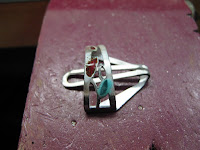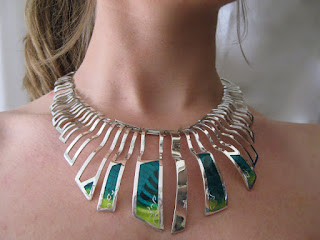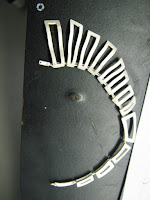Tuesday, August 31, 2010
Manufacture of Fourth Piece
First I pierced out the whole shape out of a flat plate. This meant that there would only be one solder joint which would make the piece very strong.
I then bent up the shape to form each link.
I then enamelled some of the pierced out shapes in blue and red.
After the final enamelling and cleaning I polished all the pieces.
I then made the links that do not have any enamel on them and finally I linked all the sections together to form a chain.
Fourth Piece Inspired by Tibet
I experimented with a piece that is larger on one side than the other but that is still made of thin pieces of silver and is thus very light and in keeping with my earlier pieces.
I also tried to incorporate the use of enamel to create colour on the piece.
I then decided that I would make all the sections into individual links so that there would be no unnecessary additional weight in the piece and in addition this would simplify the design.
These were a few of the link designs that I experimented with.
This was the design that I finally decided on and I then experimented with different styles of enamelling using different colours and techniques.
I liked this pattern as it made use of negative space but having such a large section in the “plique-a-jour” enamelling technique would have made it very weak.
The circles also had nothing to do with my Tibetan inspiration so I changed the pattern to include the lotus petal shape that I have been incorporating into my designs .
Wednesday, August 11, 2010
Inspiration from Tibetan Prayer Flags
Prayer Flags are put up by Buddhists in Tibet. They put these flags outside their homes and at spiritual places. It is believed that the wind will carry the prayers of the Tibetans across the countryside. Prayer flags are said to bring happiness, longevity and prosperity to the flag planter and those around him or her. The designs found on the flags often represent aspects of the enlightened mind for example compassion, perfect action, courage, etc. The flags are placed in sets of five with five colours in the order: blue, white, red, green, yellow (from left to right or from top to bottom.) The colours represent the elements: space or sky, air, fire, water and earth.
Source: http://www.prayerflags.com/

Source: http://www.prayerflags.com/

I am very inspired by the idea of the prayer flags, by how the prayers of the people are carried on the wind in this awe-inspiring country. I want my five pieces to represent these flags and therefore each piece incorporates one of the five colours.
Sunday, August 8, 2010
Manufacture of Third Piece
First I printed the pattern onto the silver plate with the Metaza photo printer.
Then I engraved the lines into the plate to make them deeper and more visible when I do the enamelling.
I then pierced out the sections that were going to be enamelled with the ‘plique-a-jour’ technique.
After soldering on the top plate I added the enamel.
First I put a thin layer of enamel onto the piece and filled the pierced out the sections for the ‘plique-a-jour’ . I then put the cloisonné wires onto the piece and let the sink into the hot enamel. After filing off the excess I fired the pieces again to create a shine.
After enamelling all the sections I started to make the rest of the neckpiece.
I pierce out the individual pieces and bent them into shape.
I then pierced out the inner section of each piece.
After making all the sections I riveted the enamel pieces together and joined the rest with tennis bracelet links that fitted together underneath the pieces so that they would be hidden.
Third Piece Inspired by Tibet
I started designing with the idea of creating form out of flat plate. So I used the idea of bending the plate into a form that would be both dynamic and flowing to represent the lotus flower.
This idea lead me to create a kink in the metal that would run over all the separate sections of the piece and by piercing out the middle section I could keep the piece very light and create interest.
I wanted to still make use of enamel so I experimented with different ways of putting the enamel on the piece. I tried using just the ‘plique-a-jour’ technique but this did not give the look I was after.
I tried putting many enamelling techniques together, such as ‘cloisonné’ where small wires are added to the enamel to create patterns, ‘basse taille’ where engraving is added to the underneath of the enamel so that there is more interest and movement in the piece, ‘champleve’ where a border is used to keep the enamel on the piece and finally ‘plique-a-jour’ where the enamel has no backing and resembles stain glass.
This was the final design that I decide on.
Subscribe to:
Comments (Atom)











































